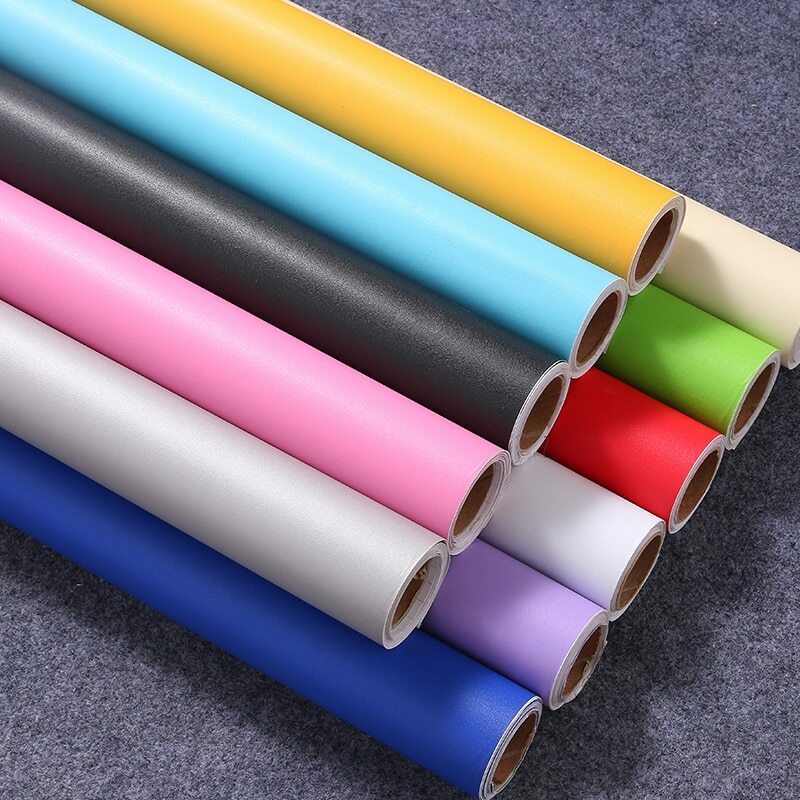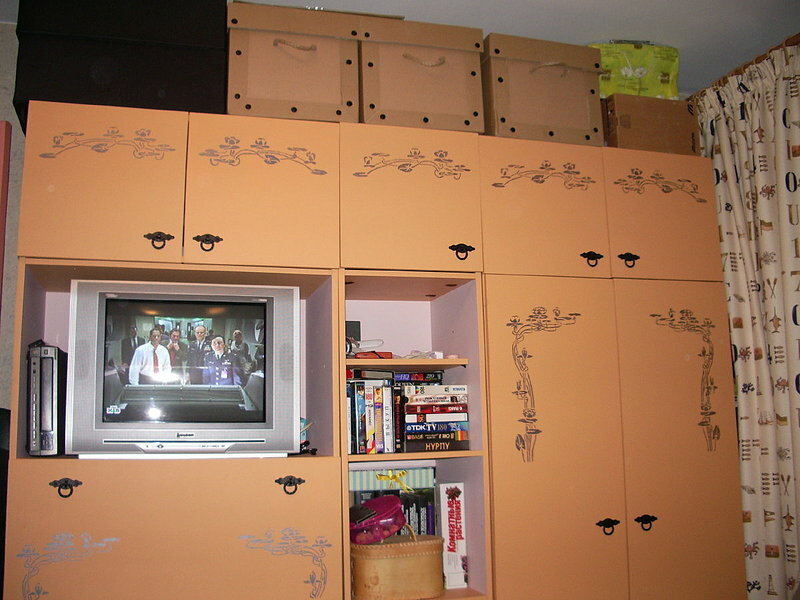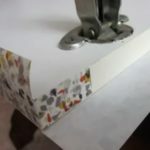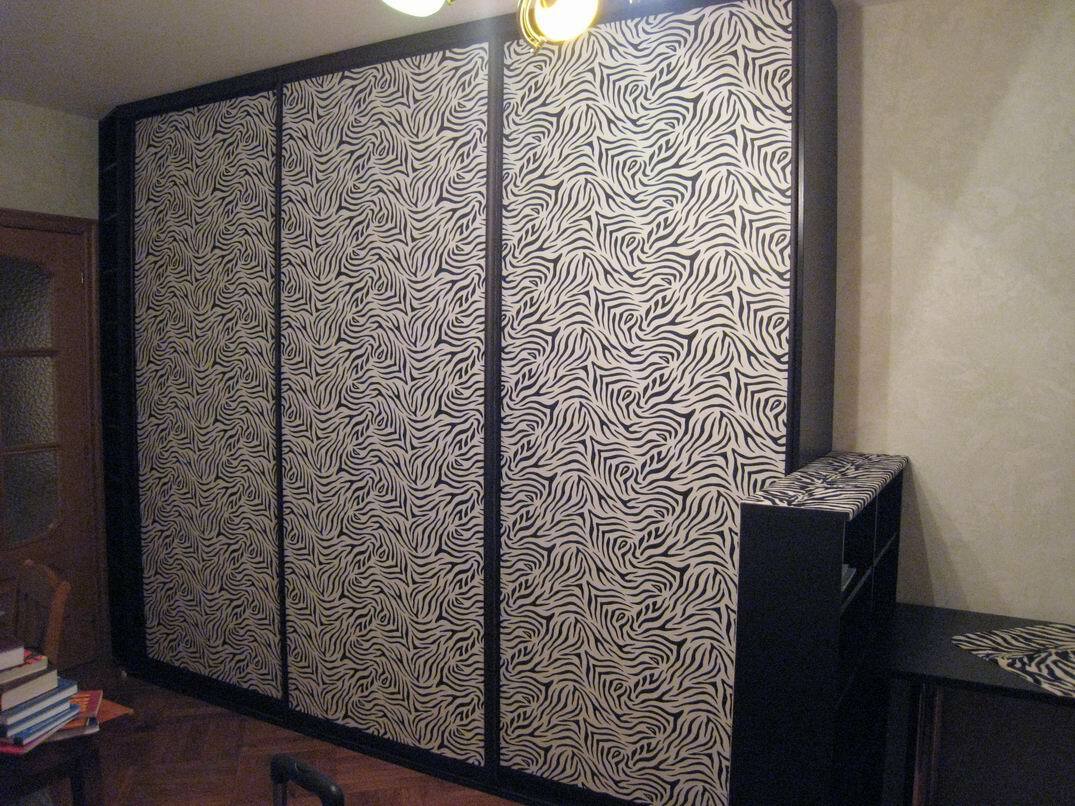Interior items, even the highest quality ones, lose their attractiveness over time. In the hustle and bustle of gray everyday life, people stop paying attention to them, and when it comes to updating the design, they try to replace old things with new ones. However, the budget does not always allow you to update the design, to give walls, furniture, doors, window sills a fresh look. In such situations, decoration is used, questions related to how to glue the cabinet with self-adhesive film, how to decorate shelves, mirrors, glass, and other elements become relevant.
Content
- Peculiarities
- Advantages and disadvantages
- Types and types of films for furniture
- Colored films for furniture
- Films for wardrobes, glass and mirrors
- How to choose
- How to properly cover furniture with self-adhesive film
- Required tools and materials
- Furniture surface preparation
- Film preparation and cutting
- Self-adhesive application on the surface
- Features of the design of corners with a film
- Mistakes to Avoid
- How to care for the glued surface
- Self-adhesive foil for door renovation
- Conclusion
Peculiarities
Self-adhesive film used for pasting furniture elements is a special material that is made from polyester, polyvinyl chloride, propylene. On the one hand, it has a decorative design in the form of a pattern, color, texture, on the other, it is covered with an adhesive layer protected by paper, which is removed before gluing. The products are produced in rolls, like regular wallpaper, but no glue is required for their application.
There are two main production technologies: calendering and casting. In the first case, the film is obtained by rolling the plastic mixture through a series of heated rolls. In the second version, colorless, transparent plastic is dissolved in solvents and poured onto a special substrate. After several additional production cycles, a fairly thin raw material is obtained.
Depending on the production method, one-layer and two-layer fabric structures are distinguished. According to the type of surface, there are glossy, matte, mirror, transparent, holographic options. The products are used in different rooms, even in the bathroom. They can be glued to the working area in the kitchen, furniture, refrigerator, windows, doors. You can also use special stickers made of the same material for decoration.
Canvases can perform a protective and decorative function. They are able to protect the surface from the negative effects of moisture, prevent scratches and chips.

Advantages and disadvantages
The film allows you to completely renew the facades of furniture, and special skills are not required to work with it. Thanks to a huge selection of textures, colors, images, you can choose the right canvas for any interior of a bedroom, living room, hallway, nursery, office. The material has gained great popularity due to its advantages, among which are:
- Low cost. Decorating will cost a lot less than buying new things.
- Interior renovation. With the help of the material, you can often change the design of any room.
- Easy assembly and disassembly. Everyone can perform work on applying and removing the canvas, without any additional tools.
- Easy cleaning. Surface cleaning can be done with a regular sponge and water.
- Manifold. A large number of shades and textures makes the products of catalogs universal, they fit into any interior.
- Moisture resistance. The cloth does not allow water to pass through, it can be used even in the kitchen and in the bathroom, but it does not withstand prolonged wetting.
- Resistance to household chemicals. For cleaning, you can use ordinary detergents.
- Resistant to temperature changes. The film is not afraid of either cold or heat, even sudden temperature changes.
Like any other material, self-adhesive products are not without drawbacks:
- Fragility. The service life of even the highest quality models does not exceed five years.
- Discoloration. Over time, under the influence of sunlight, the surface burns out, loses its original appearance.
- Surface preparation. The base for pasting must be even, otherwise all defects and irregularities will be visible.
- Weak abrasion resistance. In places of active friction, the protective layer will be rubbed off.

Types and types of films for furniture
The variety of films is very large. They differ in the way of production, structure, surface, design, scope of application. Finished products consist of three main layers:
- External. Can be polyvinyl chloride, propylene, polyester. The most common are vinyl models. They are characterized by an affordable price and a longer service life.
- Kleeva. Serves for gluing the canvas to the surface, which can be almost any - wood, chipboard, MDF, chipboard, ceramic tiles, glass, metal, plastic.
- Protective. Presented with a film layer or paper, which are removed only immediately before starting work.
As noted earlier, calendered and injection molded versions are distinguished according to the production method. By structure: one-layer and two-layer. But the design of the material can be very diverse. It can imitate various types of wood, natural and processed stone, masonry and ceramic tiles, fabric, display various images and subjects.

Colored films for furniture
Self-adhesive PVC film is an excellent tool for decorating and renovating furniture. It has a wide variety of colors and textures. The material can be used to paste over old cabinets, cabinets, chairs, tables, shelves, giving them new life, partially changing the design of the room. However, before applying it, it is necessary to prepare the surface, to make it perfectly smooth.
The choice of a specific option depends primarily on the room. So, monochromatic models of various colors are suitable for decorating children's play and kitchen sets. A canvas imitating a stone can be used to decorate a decorative fireplace. To decorate the bedroom and living room, you can choose a surface that mimics natural fabrics such as velor and velvet to add extra softness to the furnishings.

Films for wardrobes, glass and mirrors
The technology of decorating glasses and mirrors with films allows you to expand design possibilities, to give the item in question individuality and uniqueness. Self-adhesive sheet acts as a surface protection against cracks and shattering of fragments, as well as an interior decor. For work, we use color, stained glass, as well as products with plot drawings and ornaments.
The color variants are used to color the transparent glass elements of the compartment. With the help of stained glass models, interesting patterns are created, while the material has a high degree of transparency. Decorative films, while maintaining good light transmission, help to partially or completely hide the contents of the cabinet, or close windows, glass inserts on the doors from prying eyes.

How to choose
Manufacturers produce a wide range of self-adhesive films. The market offers a wide variety of models that differ not only in price, but also in material and quality. It is best to give preference to products made of PVC or acrylic; polyethylene should be discarded. You also need to adhere to the following recommendations:
- Preliminary measurements. Before you go shopping, you need to measure the surface that will be pasted over. You should take material with a small margin, since even from one manufacturer the film from different batches may differ in shade.
- The condition of the products. Before buying, the canvas will need to be inspected visually. There should be no defects on the surface.
- Company and country of origin. Preference should be given to proven companies. You can familiarize yourself with existing brands in advance, read reviews about them.
- Thickness. The thinner the product, the shorter its service life. On sale you can find models less than 0.1 mm thick.
- Operating conditions. For the bathroom and kitchen, you should choose linens that match these rooms. Usually, there are special signs on the packaging.
- Range. Branded firms produce a wide variety of goods, which, in turn, testifies to the demand for it and the quality.
- Colors, patterns, patterns are chosen in accordance with the interior, the color scheme should not contradict the existing design. If there is a voluminous flower on the film, it should fit into the interior.

How to properly cover furniture with self-adhesive film
You can glue self-adhesive on any furniture and other surfaces. Such a decorative coating serves as an excellent tool for restoration, it is a good thermal protective coating. Depending on the material of the object and its purpose, the type of film is selected. Transparent oilcloth well masks small scratches; for glass, a coating with a mosaic pattern is suitable. It is easy to do the gluing work with your own hands, it is enough to familiarize yourself with the methods and features of applying decor.

Required tools and materials
If you decide to use decorative material to give a new look to old furniture in the kitchen, nursery or bedroom, you should prepare the tools for work in advance. Self-adhesive is realized in rolls and comes in different densities. No glue is required to secure it to the surface. You need to stock up on the following items:
- Primer to improve the adhesion of both surfaces;
- Solvent;
- Pieces of soft cloth to smooth out wrinkles;
- Foam roller for air removal;
- Office knife or thin scissors.
Furniture surface preparation
Any products with an adhesive base can only be leaned against well-cleaned surfaces. All dust must be removed from the kitchen countertop, table or cabinet in the living room, degreased with an alcohol-containing liquid and dried. Additional grout will be required for wood, fabric surfaces and chipboard items. A layer of primer or special putty will allow the film to hold out for a long time.
To improve the adhesion of the film to metal or glass surfaces, additional moistening is used. The paint, the remnants of the old decor must be removed. Concrete elements must not be covered with foil. On such surfaces, you must first apply oil paint. Cracks and chips must be repaired with plaster.
The mixtures for filling gaps and smoothing surfaces should not contain latex. Vinyl films do not stick to materials with this composition.

Film preparation and cutting
Self-adhesive rolls of various widths are produced. On the back of the protective layer of each unit, there is a special square marking, which makes cutting and fitting easier. It is comfortable to use this method if the canvas is of the same tone. It is better to cut the film for tiles or with a pattern from the front side so as not to disturb the outline of the image.
For cutting, use a clerical knife or well-sharpened scissors. To get the perfect line, use a long ruler. It is not recommended to jam and bend the film for the convenience of cutting, it will then adhere poorly.
Self-adhesive application on the surface
There are several options and ideas for applying the film to the surface. The choice of the right one depends on the type of backing and the vinyl roll itself. The simplest method is to simply peel off the protective layer and gradually press the film against the part. The released part is applied to the surface, pressed and the air is expelled. The most effective movements are from the middle to the side, from the center to the front. When a part of the coating is fixed, the remaining paper is pulled out, the operation to remove air is repeated.
If air bubbles form after gluing, miniature cuts are made in these places and the material is pressed to the base. If the format of the elements is large, you need to constantly monitor the correct docking. Cracks should not form in these places. In case of accidental shift or overlap of the corners, the film is glued with an overlap. The excess strip is cut off with a clerical knife along a metal ruler.















Features of the design of corners with a film
A sophisticated gluing method is used to finish rounded corners. In this case, heating is indispensable. At the fold, the film is heated with a hairdryer, pulled to sufficiently fit the convex corner or the correct location in the concave. Good quality vinyl material can be pulled loosely over a standard corner of the table. In this case, you do not have to make cuts. It will be enough to carefully remove the excess with a knife.
If there is no possibility of heating, you can stick the film on the round corners. To do this, you need to attach vinyl to the sidewalls and wrap the canvas down. At the very corner, the film is cut, a small run of a few millimeters is made.

Mistakes to Avoid
To get an excellent result, some nuances should be taken into account when applying self-adhesive film to furniture. It is important to avoid the following mistakes:
- The material should be cut with a small margin;
- So that after pasting, defects are not visible. Any surface must be carefully prepared;
- The film can only be applied to a perfectly clean, grease-free and dried surface;
- It is recommended to separate wide rolls only by the internal markings. If it is 3D printed or drawing, it is necessary to make marks on the front side in advance.

How to care for the glued surface
Furniture covered with foil is wiped with a damp cloth or washed with soapy water. You can use coarse sponges, but not on a metal base. It is prohibited to use aggressive household chemicals. It is also not recommended to press hard and rub the surface while cleaning.
Difficult dirt is removed with ethyl alcohol. The glue protruding along the edges of the film is removed with a soft sponge dipped in warm water. Velor decorative coatings need the most delicate care.

Self-adhesive foil for door renovation
At the initial stage, the door structure is prepared for pasting. Adhering to the following instructions step by step, such work can be done independently in a few hours:
- Marking. Transfer the previously measured dimensions of the door to the back of the film. Thanks to the millimeter grid on the protective layer, work can be done with high precision;
- Cut the vinyl roll. Strictly according to the marking, we cut segments of a perfectly accurate size and with even edges;
- We apply alternately pieces of film to the upper part of the door, separate the paper layer, press down, paste over;
- Gradually remove the protection and place the adhesive vinyl against the surface. Then we smooth it out with a rubber spatula, carefully getting rid of air bubbles;
- At the ends we wrap the remaining self-adhesive and cut off the excess. Overlap should be kept to a minimum.

Conclusion
Self-adhesive for furniture is an ideal decor option. The budget material is able to mask damage, give an aesthetic appearance to old worn-out items. All elements remain strong and reliable. You can use vinyl in rolls for structures made of any materials, decorate beautifully different surfaces.
